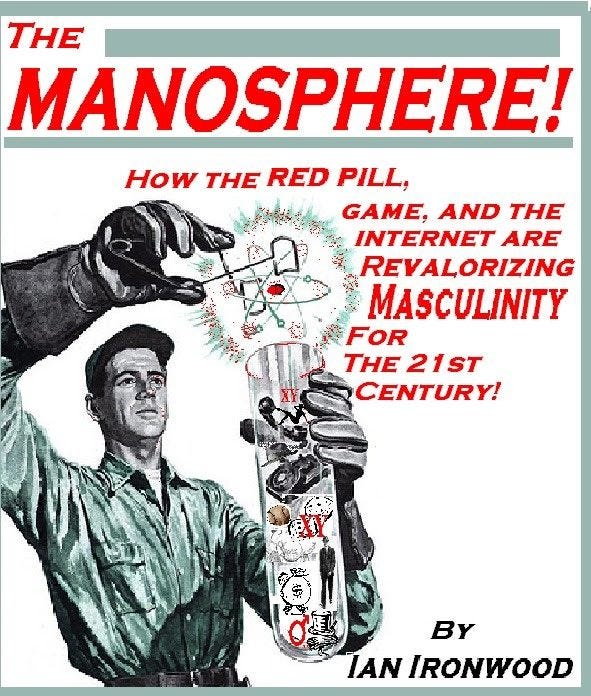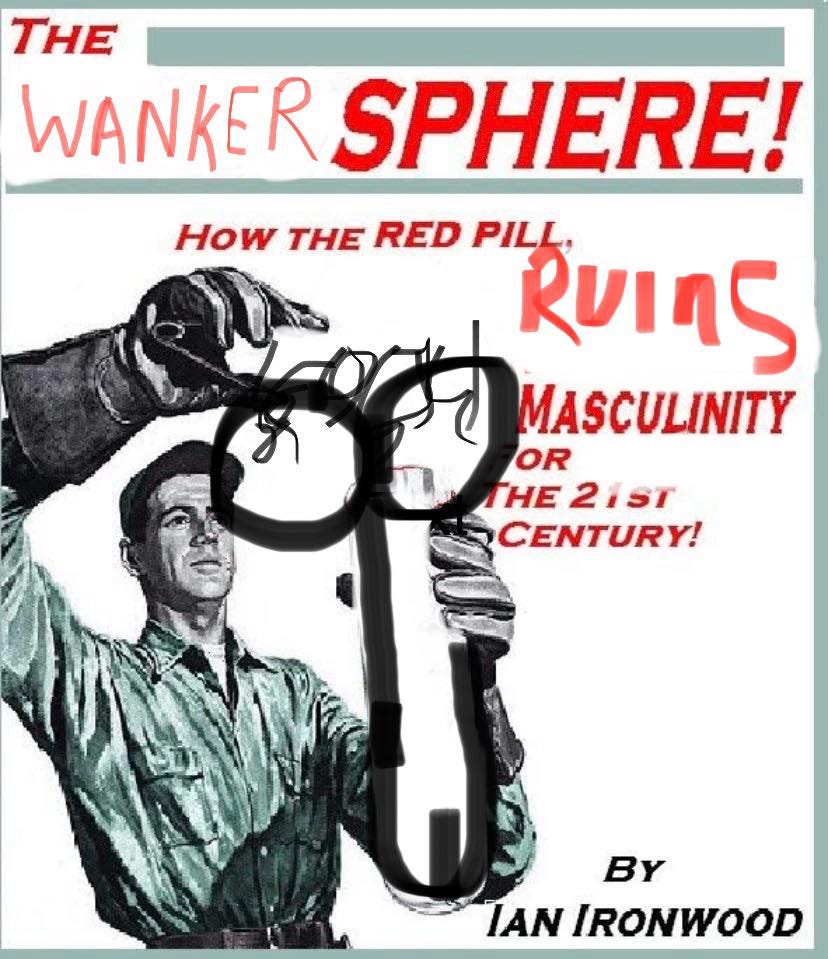Manscaping the Manosphere
1. Adolescence
Towards the end of the intense, claustrophobic and desperate closing episode of the acclaimed 2025 Netflix series, Adolescence – in a moment of shared despair between the parents of a boy who was radicalised online by figures like Andrew Tate, and ended up killing a girl from his class at school – both parents lament their situation and berate themselves for not paying more attention to what their son was being exposed to. They just thought he was safely gaming in his bedroom. Yet, really, the pubescent boy was being radicalised about women and girls, online, in the so-called ‘manosphere’. Both parents try to persuade themselves that they could not have known this, that it was not their fault. At one point, the father holds out his phone and expresses exasperation that there is no escaping from it: ‘like the time that bloke popped up on my phone!’, he cries: ‘I was only looking for ideas for the gym!’
2. Click Bait
There is little to no escape for some from the so-called manosphere. (But it is not really a sphere.) Certainly, the networked algorithms that track me and follow me around, trying to keep me engaged with my daily procrastination, seem keen to serve me up its gateway slop. I too sometimes look for ‘ideas for the gym’, and I often notice the dubious character of the clickbait titles and previews of some of the suggested YouTube films and Facebook reels that come up (never mind what happens on the total-attention-control cesspit that is Instagram). Fortunately, I am a 54-year-old man and do not (still) have the predictable cluster of insecurities that a teenage or twenty-something might have – insecurities that would have been part and parcel of what would lead such a person to look for ideas for the gym in the first place.
3. Sad Men
The so-called manosphere is actually a fairground hall of mirrors in which insecure men pretend to be secure men in order to sell lifestyles and gain sponsorships based around the idea that the reason some boys feel sad and insecure is because of feminism. It’s pretty much Tyler Durden 101, and indeed Fight Club is much beloved of such men and boys because Brad Pitt looks hot and makes speeches about men’s weakness being all women’s fault. Such fans of this film seem able to overlook the fact that Durden is a paranoid schizophrenic projection from the fevered mind of someone that consumerism has driven crazy. He’s not real, and he’s an arsehole, but he looks hot. So, I suppose that’s good enough. In the hall of mirrors of the ‘manosphere’, wannabe Tyler Durdens tout misogyny wrapped up in pseudoscience in order to expel the scapegoat (women) and bond the community in a shared identity predicated on violent exclusion. It has the same logic as what Freud called a ‘tendentious joke’, in which 1. men desire the woman; 2. men can’t just have the woman; 3. Therefore men are nasty about the woman in order to feel like they can ‘have’, beat, control or humiliate her symbolically, in language, in ‘fun’. It’s pretty pathetic.
4. Against the Manosphere
It’s also badly named. I want to urge people not to use the term ‘manosphere’, and for two main reasons. First, ‘manosphere’ is neither descriptively nor analytically fitting for this thing or process. Second, the term manosphere was coined by a proponent of the very problem it names. The pornographer who wrote the book The Manosphere: A New Hope for Masculinity, and with it put the term into circulation, was very much in favour of the ethos and orientation he was naming. Said pornographer both writes (or at least cobbles together blog posts) and graphs porn under the embarrassing puerile pen name ‘Ian Ironwood’. (I know. I know.) Given this, I ask you, what self-respecting scholar, concerned parent, or anyone at all would want to use the preferred term of the pornographer who wrote the manifesto?
Original/current cover, as shown on Amazon
5. Sphere or Scape?
The term is a play on ‘blogosphere’. This dates it too. But now it’s neither dominated by blogs nor is it spherical. Of course, I confess, viewed from certain perspectives, it might seem ‘sphere-like’ or ‘sphere-ish’, if not ‘spherical’. A bubble at best. A vortex, perhaps. Or a carnivorous sundew plant maybe. Or bubbles in a bog or a cesspit. But I’m moving too fast. Anyway, despite my penchant for the philosophy of Peter Sloterdijk, who has written many volumes that argue we can best understand all things about human society, culture, and psychology through the metaphors of different kinds of spheres (globes, foams, etc.), I would suggest that a better image is ‘scape’. The manscape.
Improved cover suggestion, proposed by my daughter
6. Manscaping
Even better than manscape is manscaping. What we have here is not really a noun-object – a fixed or permanent thing. It’s more of a verb-process. As the philosopher Gilles Deleuze might say, a process of becoming: a work in progress, something never quite there and never quite that – we are dealing with a process of manscaping rather than a fixed object (manscape). Of course, a landscape of fixed objects (the manscape) is produced by the process of manscaping. Just like a landscape, garden or grounds are planted and pruned and honed and trained and weeded into shape over time, just like a body is built in the gym. But as every gardener and gym-goer knows, we’re never there yet. Ask a gardener or gym-goer about a state of affairs – this bed, that muscle – and they will answer in terms not merely of the now, but very much in terms of a narrative of becoming, from the inferior thing it once was to superior thing they are working and hoping for it to become.
7. Back, Sack and Crack
And yes, I know the conventional meaning of ‘manscape’. That’s another reason it works better. ‘Manscaping’ refers to male self-grooming, especially shaving, trimming and styling pubic hair. It can of course refer to men shaving their legs, chest and other body hair – plucking their nostrils, waxing their back, trimming their eyebrows, and so on. But primarily it evokes the pubic area. Before American sensitivities and the cold dead eyes of humourless marketing language fully colonised British discursive space, in the UK (when David Beckham was at the peak of his footballing fame) manscaping used to be referred to as a ‘back, sack and crack’ wax.
8. From Combover Subject to Waxy Plasticity
Manscaping is a more useful term because it is all about the gordian tangle of desire for self-improvement, for growing up, combined with insecurity and being captured and ensnared in the forces of socially mediated compulsory vanity. Rey Chow calls it ‘coercive mimeticism’. Lauren Berlant once used the term ‘combover subject’ as an image that registered people’s attempts to disguise a source of insecurity and anxiety. Today, this image of an insecure older man from a bygone age needs to be generalised and updated. The requisite new concept-metaphor resources can be drawn from every element of manscaping. The manscape is the shiny whitening of the arse and the making waxy smooth of cock and shaven balls, all on a buff or hench off-the-peg body. We might call it the new waxy plasticity. In waxy plasticity, the catatonic limb just stays where someone else has put it. The subject defined by waxy plasticity has been moulded into the medium of Instagram.
9. Mirror/Stage
Manscaping is an attempt to ‘improve’ the self along massively commodified lines for the imagined delectation of a fantasized female who is awestruck – struck dumb, or dumber (remember, she’s inferior, etc.) – by the neatness of the ‘scape’. But, of course, the imagined female gaze is the alibi for a mediated and formulaic autoerotic performance, one that is at root narcissistic and homoerotic. And, yes, of course, this is clever détournement 101 in itself: call the misogynistic homophobe not merely feminine but also gay. I know this. But, hey, you have to say what you see. And to my eyes, the manscape looks a lot like a remade Village People performance for the Instagrift age. (Let’s just call this #darkwoke, shall we?)



Comments
Post a Comment